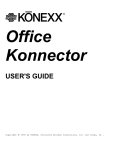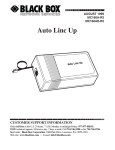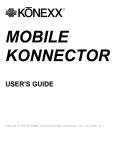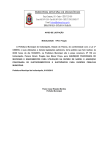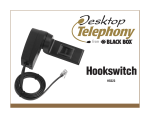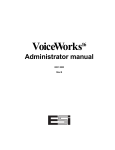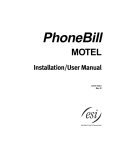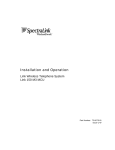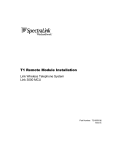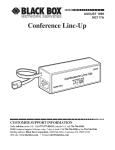Download Black Box Headphones hs300a User's Manual
Transcript
2.4 GHz Wireless Remote Unit with Hookswitch HS300A HS301A FCC INFORMATION FEDERAL COMMUNICATIONS COMMISSION AND INDUSTRY CANADA RADIO FREQUENCY INTERFERENCE STATEMENTS This equipment generates, uses, and can radiate radio frequency energy and if not installed and used properly, that is, in strict accordance with the manufacturer’s instructions, may cause interference to radio communication. It has been tested and found to comply with the limits for a Class A computing device in accordance with the specifications in Subpart J of Part 15 of FCC rules, which are designed to provide reasonable protection against such interference when the equipment is operated in a commercial environment. Operation of this equipment in a residential area is likely to cause interference, in which case the user at his own expense will be required to take whatever measures may be necessary to correct the interference. Changes or modifications not expressly approved by the party responsible for compliance could void the user’s authority to operate the equipment. This digital apparatus does not exceed the Class A limits for radio noise emission from digital apparatus set out in the Radio Interference Regulation of Industry Canada. Le présent appareil numérique n’émet pas de bruits radioélectriques dépassant les limites applicables aux appareils numériques de classe A prescrites dans le Règlement sur le brouillage radioélectrique publié par Industrie Canada. 1 2.4 GHZ WIRELESS REMOTE UNIT WITH HOOKSWITCH FCC REQUIREMENTS FOR TELEPHONE-LINE EQUIPMENT 1. The Federal Communications Commission (FCC) has established rules which permit this device to be directly connected to the telephone network with standardized jacks. This equipment should not be used on party lines or coin lines. 2. If this device is malfunctioning, it may also be causing harm to the telephone network; this device should be disconnected until the source of the problem can be determined and until the repair has been made. If this is not done, the telephone company may temporarily disconnect service. 3. If you have problems with your telephone equipment after installing this device, disconnect this device from the line to see if it is causing the problem. If it is, contact your supplier or an authorized agent. 4. The telephone company may make changes in its technical operations and procedures. If any such changes affect the compatibility or use of this device, the telephone company is required to give adequate notice of the changes. 5. If the telephone company requests information on what equipment is connected to their lines, inform them of: a. The telephone number that this unit is connected to. b. The ringer equivalence number. c. The USOC jack required: RJ-11C. d. The FCC registration number. 2 CDC STATEMENT Items (b) and (d) can be found on the unit’s FCC label. The ringer equivalence number (REN) is used to determine how many devices can be connected to your telephone line. In most areas, the sum of the RENs of all devices on any one line should not exceed five (5.0). If too many devices are attached, they may not ring properly. 6. In the event of an equipment malfunction, all repairs should be performed by your supplier or an authorized agent. It is the responsibility of users requiring service to report the need for service to the supplier or to an authorized agent. CERTIFICATION NOTICE FOR EQUIPMENT USED IN CANADA The Canadian Department of Communications label identifies certified equipment. This certification means that the equipment meets certain telecommunications-network protective, operation, and safety requirements. The Department does not guarantee the equipment will operate to the user’s satisfaction. Before installing this equipment, users should ensure that it is permissible to be connected to the facilities of the local telecommunications company. The equipment must also be installed using an acceptable method of connection. In some cases, the company’s inside wiring associated with a single-line individual service may be extended by means of a certified connector assembly (extension cord). The customer should be aware that compliance with the above conditions may not prevent degradation of service in some situations. Repairs to certified equipment should be made by an authorized Canadian maintenance facility—in this case, your supplier. Any repairs or alterations made by the user to this equipment, or equipment malfunctions, may give the telecommunications company cause to request the user to disconnect the equipment. Users should ensure for their own protection that the electrical ground connections of the power utility, telephone lines, and internal metallic water pipe system, if present, are connected together. This precaution may be particularly important in rural areas. 3 2.4 GHZ WIRELESS REMOTE UNIT WITH HOOKSWITCH CAUTION: Users should not attempt to make such connections themselves, but should contact the appropriate electric inspection authority, or electrician, as appropriate. The LOAD NUMBER (LN) assigned to each terminal device denotes the percentage of the total load to be connected to a telephone loop which is used by the device, to prevent overloading. The termination on a loop may consist of any combination of devices, subject only to the requirement that the total of the load numbers of all the devices does not exceed 100. NORMAS OFICIALES MEXICANAS (NOM) ELECTRICAL SAFETY STATEMENT INSTRUCCIONES DE SEGURIDAD 1. Todas las instrucciones de seguridad y operación deberán ser leídas antes de que el aparato eléctrico sea operado. 2. Las instrucciones de seguridad y operación deberán ser guardadas para referencia futura. 3. Todas las advertencias en el aparato eléctrico y en sus instrucciones de operación deben ser respetadas. 4. Todas las instrucciones de operación y uso deben ser seguidas. 5. El aparato eléctrico no deberá ser usado cerca del agua—por ejemplo, cerca de la tina de baño, lavabo, sótano mojado o cerca de una alberca, etc.. 6. El aparato eléctrico debe ser usado únicamente con carritos o pedestales que sean recomendados por el fabricante. 4 NOM STATEMENT 7. El aparato eléctrico debe ser montado a la pared o al techo sólo como sea recomendado por el fabricante. 8. Servicio—El usuario no debe intentar dar servicio al equipo eléctrico más allá a lo descrito en las instrucciones de operación. Todo otro servicio deberá ser referido a personal de servicio calificado. 9. El aparato eléctrico debe ser situado de tal manera que su posición no interfiera su uso. La colocación del aparato eléctrico sobre una cama, sofá, alfombra o superficie similar puede bloquea la ventilación, no se debe colocar en libreros o gabinetes que impidan el flujo de aire por los orificios de ventilación. 10. El equipo eléctrico deber ser situado fuera del alcance de fuentes de calor como radiadores, registros de calor, estufas u otros aparatos (incluyendo amplificadores) que producen calor. 11. El aparato eléctrico deberá ser connectado a una fuente de poder sólo del tipo descrito en el instructivo de operación, o como se indique en el aparato. 12. Precaución debe ser tomada de tal manera que la tierra fisica y la polarización del equipo no sea eliminada. 13. Los cables de la fuente de poder deben ser guiados de tal manera que no sean pisados ni pellizcados por objetos colocados sobre o contra ellos, poniendo particular atención a los contactos y receptáculos donde salen del aparato. 14. El equipo eléctrico debe ser limpiado únicamente de acuerdo a las recomendaciones del fabricante. 15. En caso de existir, una antena externa deberá ser localizada lejos de las lineas de energia. 16. El cable de corriente deberá ser desconectado del cuando el equipo no sea usado por un largo periodo de tiempo. 5 2.4 GHZ WIRELESS REMOTE UNIT WITH HOOKSWITCH 17. Cuidado debe ser tomado de tal manera que objectos liquidos no sean derramados sobre la cubierta u orificios de ventilación. 18. Servicio por personal calificado deberá ser provisto cuando: A: El cable de poder o el contacto ha sido dañado; u B: Objectos han caído o líquido ha sido derramado dentro del aparato; o C: El aparato ha sido expuesto a la lluvia; o D: El aparato parece no operar normalmente o muestra un cambio en su desempeño; o E: El aparato ha sido tirado o su cubierta ha sido dañada. 6 TRADEMARKS USED IN THIS MANUAL TRADEMARKS USED IN THIS MANUAL AT&T® and Merlin® are registered trademarks of American Telephone and Telegraph Company. Siemens® is a registered trademark of Siemens Aktiengesellschaft. Toshiba® is a registered trademark of Toshiba Corporation. UL® is a registered trademark of Underwriters Laboratories Incorporated. Any other trademarks mentioned in this manual are acknowledged to be the property of the trademark owners. 7 2.4 GHZ WIRELESS REMOTE UNIT WITH HOOKSWITCH Contents 1. Specifications. . . . . . . . . . . . . . . . . . . . . . . . . . . . . . . . . . . . . . . . . . . . . . . . . . . . . . . . . . . . . . . . . . . 9 2. Introduction . . . . . . . . . . . . . . . . . . . . . . . . . . . . . . . . . . . . . . . . . . . . . . . . . . . . . . . . . . . . . . . . . . 10 2.1 Description. . . . . . . . . . . . . . . . . . . . . . . . . . . . . . . . . . . . . . . . . . . . . . . . . . . . . . . . . . . . . . . . . 10 2.2 Components. . . . . . . . . . . . . . . . . . . . . . . . . . . . . . . . . . . . . . . . . . . . . . . . . . . . . . . . . . . . . . . . 10 3. Installation . . . . . . . . . . . . . . . . . . . . . . . . . . . . . . . . . . . . . . . . . . . . . . . . . . . . . . . . . . . . . . . . . . . . 12 3.1 Assembling the Base and Connecting to the Telephone . . . . . . . . . . . . . . . . . . . . . . . . . . . . 12 3.2 Checking the System . . . . . . . . . . . . . . . . . . . . . . . . . . . . . . . . . . . . . . . . . . . . . . . . . . . . . . . . . 13 3.3 Charging the Battery . . . . . . . . . . . . . . . . . . . . . . . . . . . . . . . . . . . . . . . . . . . . . . . . . . . . . . . . . 13 3.4 Before Setting Up to the Telephone . . . . . . . . . . . . . . . . . . . . . . . . . . . . . . . . . . . . . . . . . . . . 14 3.5 Setting Telephone Compatibility and Transmit Adjustments . . . . . . . . . . . . . . . . . . . . . . . . 14 3.5.1 Step 1: Setting Telephone Compatibility . . . . . . . . . . . . . . . . . . . . . . . . . . . . . . . . . . . . . 14 3.5.2 Step 2: Adjusting the Transmit (Microphone) Sound Level. . . . . . . . . . . . . . . . . . . . . . 15 3.6 Telephone Compatibility Guide. . . . . . . . . . . . . . . . . . . . . . . . . . . . . . . . . . . . . . . . . . . . . . . . 15 4. Operation. . . . . . . . . . . . . . . . . . . . . . . . . . . . . . . . . . . . . . . . . . . . . . . . . . . . . . . . . . . . . . . . . . . . . 17 4.1 Using with a Headset. . . . . . . . . . . . . . . . . . . . . . . . . . . . . . . . . . . . . . . . . . . . . . . . . . . . . . . . . 17 4.2 Using with a Handset . . . . . . . . . . . . . . . . . . . . . . . . . . . . . . . . . . . . . . . . . . . . . . . . . . . . . . . . 17 4.3 Using the Pocket and Belt Clips . . . . . . . . . . . . . . . . . . . . . . . . . . . . . . . . . . . . . . . . . . . . . . . . 17 4.4 Adjusting the Volume . . . . . . . . . . . . . . . . . . . . . . . . . . . . . . . . . . . . . . . . . . . . . . . . . . . . . . . . 18 4.5 Muting the Microphone . . . . . . . . . . . . . . . . . . . . . . . . . . . . . . . . . . . . . . . . . . . . . . . . . . . . . . 18 4.6 Recharging the Battery . . . . . . . . . . . . . . . . . . . . . . . . . . . . . . . . . . . . . . . . . . . . . . . . . . . . . . . 19 5. Troubleshooting . . . . . . . . . . . . . . . . . . . . . . . . . . . . . . . . . . . . . . . . . . . . . . . . . . . . . . . . . . . . . . . 20 5.1 Problems and Solutions . . . . . . . . . . . . . . . . . . . . . . . . . . . . . . . . . . . . . . . . . . . . . . . . . . . . . . 20 5.2 Accessories . . . . . . . . . . . . . . . . . . . . . . . . . . . . . . . . . . . . . . . . . . . . . . . . . . . . . . . . . . . . . . . . . 21 5.3 Batteries . . . . . . . . . . . . . . . . . . . . . . . . . . . . . . . . . . . . . . . . . . . . . . . . . . . . . . . . . . . . . . . . . . . 21 5.4 Calling Black Box . . . . . . . . . . . . . . . . . . . . . . . . . . . . . . . . . . . . . . . . . . . . . . . . . . . . . . . . . . . 22 5.5 Shipping and Packaging . . . . . . . . . . . . . . . . . . . . . . . . . . . . . . . . . . . . . . . . . . . . . . . . . . . . . . 22 8 CHAPTER 1: Specifications 1. Specifications Baseband Modulation— ADPCM Battery Life—12 hours of continuous use, on-line; 80 hours of continuous use, off-line Battery Recharge Time— 3 hours Compliance—UL® 1459, CSA, FCC Parts 15 and 68, IC RSS-210 Coverage—125,000 square feet Frequency—2400 to 2483 MHz (base and remote) Range—200 ft. (61 m) (indoors) Power—Base: 7.5 VDC, 500 mA maximum; Remote: 3.6-V rechargeable NiMH, 550-mAH battery Size—Base: 6"H x 4"W x 0.8"D (15.2 x 10.2 x 2 cm); Remote: 4"H x 2.5"W x 1"D (10.2 x 6.4 x 2.5 cm) Weight—Base: 6.2 oz. (175.8 g); Remote: 3.3 oz. (93.6 g) Channels—120 RF Modulation—FDMA Channel Selection— Automatic Compatibility—All business phones that comply with RF immunity spec: CISPR24: 1997, modified; Carbon, Electric, AT&T®: Switch selectable; Siemens® Dyad: Accessory hookup cord Systems Per Facility—50 per coverage area (more depending on building design) Transmission Security— Digital encryption (Spread Spectrum, Frequency Hopping) 9 2.4 GHZ WIRELESS REMOTE UNIT WITH HOOKSWITCH 2. Introduction 2.2 Components A. Base 2.1 Description The 2.4 GHz Wireless Amplifier and the Remote Unit use Spread Spectrum technology to give you wireless access to your phone. With the wireless system, you’re free to find a file, confer with a colleauge, check with shipping, or roam the building—without putting your caller on hold. NOTE The 2.4 GHz Wireless Headset system includes the base unit, remote unit, Hookswitch, and Pro-Fit Headset. (Separate documentation is available for the Hookswitch and Pro-Fit Headset. Call Black Box at 724-746-5500 for details.) The 2.4 GHz Wireless Remote Unit includes the Remote Unit and Hookswitch. Both include the components listed in Section 2.2. 30Headset/Handset Selector I. Transmit Adjustment II. Telephone Compatibility Adjustment 4 On-line Indicator 5 Battery Recharging Indicator B. Headset Stand C. Remote III. On-line Indicator 7 Volume Control Button 6 Mute Button IV. Hookswitch Activation Button 10 CHAPTER 2: Introduction A. B. 1 2 3 4 5 6 7 8 I. A B C D E F G II. C. III. IV. VI. V. E. F. D. VII. G. D. Base Stand 11 2.4 GHZ WIRELESS REMOTE UNIT WITH HOOKSWITCH 3. Installation 3.1 Assembling the Base and Connecting to the Telephone 1. Disconnect the handset cord from the telephone and connect it to the port marked with the 0 icon at the bottom of the base. Connect one end of the telephone interface cord to the telephone handset port and the other end to the bottom of the base marked with the 1 icon. Connect the AC power adapter to the port marked with the 2 icon at the bottom of the base, and then to the power outlet (Figure 3-1). Turn on the power. 12 Figure 3-1. Connecting the Cords. 2. Mount the base by aligning the tabs extending from the bottom of the base with the corresponding slots on the stand. Turn clockwise until secure. The 3 cords should extend from the back of the base. Align the center tab of the headset stand with the port on either side of the base. Slide the ends of the headset stand over the top of the base until it locks into place (Figure 3-2). Figure 3-2. Mounting the Base. 3. Align the tab at the bottom of the battery with the notch on the back of the remote. Push the battery flush against the remote until it clicks into place (Figure 3-3). CHAPTER 3: Installation now working. If the on-line indicator does not flash, recheck assembly (Figure 3-5). Figure 3-3. Aligning the Tab. 4. Connect the headset to the bottom of the remote. Insert the remote into the base (see Figure 3-4). Either side may be used. The battery charge indicator marked with the 5 icon on the base will light up. This will be referred to as the front of the base. Fully charge the remote for 3 hours before using. Figure 3-4. Connecting the Headset. 3.2 Checking the System Put the system in headset mode by pressing once on the headset/ handset selector on top of the base. The on-line indicator marked on the base with the 4 icon will light. After 5 to 45 seconds, the on-line indicator on the top of the remote will start to flash (the base searches for an open transmission channel only on the first time). The system is Figure 3-5. Checking the Assembly. 3.3 Charging the Battery The nickel-metal-hydride battery (NiMH) for the remote is not charged when delivered. To charge, place the remote with the battery in the base for at least 3 hours before making the adjustments below. 13 2.4 GHZ WIRELESS REMOTE UNIT WITH HOOKSWITCH 3.4 Before Setting Up to the Telephone 1. Make sure the headset/handset selector marked with the 30 icon on top of the base is in the headset position. The selector is in the headset position when the on-line indicator (marked with the 4 icon) on the front of the base lights up and the online indicator on the top of the remote is flashing. If the lights are off, the selector is in the handset position. Press the handset/headset selector once to activate the headset (Figure 3-6). 3.5 Setting Telephone Compatibility and Transmit Adjustments 3.5.1 STEP 1: SETTING TELEPHONE COMPATIBILITY 1. Put your headset on, lift the handset from the telephone, and listen for a dial tone in your headset. Figure 3-6. Activating the Headset. 2. Make sure the mute function on the remote is off. If the mute button is on, you will hear a double beep in your headset every 5 seconds. Turn it off by pressing the mute button on the remote marked with the 6 icon once. 3. If your telephone has volume control, set the volume to mid-range. Control the headset volume through the remote. 14 2. If there is no dial tone, adjust the telephone compatibility switch marked A-G on the rear of the base. Move from A to G until the dial tone is clear. If the dial tone is just as clear in position A as in G, leave the switch in position A. Most phones will use position A or position G (Figure 3-7). CHAPTER 3: Installation as when you used the handset. Adjust the switch marked 1-8 on the rear of the base as follows: 1 2 3 4 5 6 7 8 A B C D E F G Figure 3-7. Adjusting the Telephone Compatibility Switch. 3.5.2 STEP 2: ADJUSTING THE TRANSMIT (MICROPHONE) SOUND LEVEL Change from the headset to the handset position by pressing the headset/handset selector (marked on top of the base with the 30 icon) once. Call someone using your handset, then switch over to your headset. Ask for help evaluating the sound level of your voice so that the level is the same Adjust position from 1 to 8 (1 is softest, 8 is loudest) by first talking in the handset and then in the headset for each position. When the person hears no difference when you talk into the handset or headset, you have the correct setting. (Most settings will be between 5-7.) If the best setting is 7 or 8, move the AG switch to position G (Figure 3-8). 1 2 3 4 5 6 7 8 A B C D E F G Figure 3-8. Adjusting the Transmit Sound Level. 3.6 Telephone Compatibility Guide For optimal performance, adjust the Telephone Compatibility switch to correspond with the type of telephone listed in Table 3-1. The following chart is only a partial list of compatible telephone systems. If your phone is not in the chart, call Black Box Technical Support at 724-7465500. 15 2.4 GHZ WIRELESS REMOTE UNIT WITH HOOKSWITCH Table 3-1. Telephone Compatibility Guide Manufacturer System Phone Set Setting AT&T (Lucent) Definity Merlin® ISDN 1A2 Merlin Legend Consumer Products 7100, 7300, 7400 Series BTN, BIS, & 7000 Series 6500, 7500 Series 2500 Series MLX Series Traditional & Feature A A A G A A Comdial Executech, Impact All Sets A Mitel SX Series All Supersets A NEC Electra D-Term Series 2, 3, E A Executone Encore All Sets G ITT/Alcatel 501, 601 2500 & 2800 Series G Toshiba Strata SE & DK EKT 2101-3102, 6010-6025 G ETS Series G Siemens-Rolm 16 CHAPTER 4: Operation 4. Operation 4.2 Using with a Handset 1. Make sure the headset/ handset selector on top of the base is in the handset position. 4.1 Using with a Headset 1. Make sure the headset/handset selector on top of the base is in the headset position. Put on the headset, pick up the handset, and answer the phone or make a call. 2. To end the call, put the handset down. 3. When you answer or make a call using the headset, the on-line indicator on the base starts flashing. This means the base is communicating with the remote (Figure 4-1). Figure 4-1. On-Line Indicator Flashing. 4. To move away from your desk during the call, remove the remote from the base and clip it to your belt or put it in your pocket. You can now move freely up to 200 feet away from the base. If you move out of transmission range, you will hear a double beep in your headset every 10 seconds. 2. Pick up the handset to answer the phone or make a call as usual. 3. To end the call, put down the handset. 4.3 Using the Pocket and Belt Clips 1. The remote ships with the pocket clip installed. To use, slide the wire clip behind the fabric of your pocket. 2. To use the belt clip, first remove the wire pocket clip. While holding the remote face down, gently pull the wire clip from both sides of the unit (Figure 4-2). 17 2.4 GHZ WIRELESS REMOTE UNIT WITH HOOKSWITCH Figure 4-2. Removing the Pocket Clip. 3. Slide the belt clip onto the back of the remote until it clicks into place (Figure 4-3). 18 Figure 4-3. Sliding the Belt Clip into Place. 4.4 Adjusting the Volume To turn the sound level up or down in your headset, press successively on the volume control button marked with the 7 icon on the front of the remote (Figure 4-4). If you have reached the maximum or minimum level, you will hear a beep. Figure 4-4. Adjusting the Volume. 4.5 Muting the Microphone To talk without the other party hearing you, press the mute button (marked with the 6 icon on the front of the remote). (See Figure 4-5.) When the microphone is muted, you will hear a double beep in your headset every 5 seconds. When CHAPTER 4: Operation the mute function is on, you can still hear the other party. Figure 4-5. Muting the Microphone. lights up while the battery is in the base. It takes 3 hours to fully recharge the battery. A fully charged battery provides 12 hours of continuous talktime. If the battery power gets too low, you’ll hear a beep in your headset every 20 seconds. When charging the battery overnight, put the system in handset mode (Figure 4-6). An optional second battery can charge in the base while the remote is in use, thus allowing 24-hours-a-day, seven-days-a-week talktime. To replace the battery, press the button on the back of the battery and pull. Figure 4-6. Charging the Battery. 4.6 Recharging the Battery To ensure optimum battery life, place the remote in the base when not in use. The recharging indicator on the base, marked with the 5 icon, automatically 19 2.4 GHZ WIRELESS REMOTE UNIT WITH HOOKSWITCH 5. Troubleshooting 5.1 Problems and Solutions If you do not get a dial tone: • Check to see that all cords and jacks are connected. • Make sure that the Quick Disconnect connector is fully inserted into the remote. • Make sure that the AC adapter is plugged in and has power. • Try the compatibility setting on A and G. • Make sure that the Headset button located on the top of the base is in the on mode and the 4 LED is lit. • Make sure that the battery is properly installed in the beltpack. 20 • Make sure that the battery is fully charged (3 hours minimum). • Make sure the serial numbers on the bottom of the base unit and back of beltpack units match. Because of the security circuits, the beltpack and base must match for operation. If the other party has a hard time hearing you: • Make sure the MUTE on the beltpack is off (an audible beep will be heard in the headset every five seconds if mute is on). • Re-adjust the transmit level as shown in Sections 5.2 and 3.6. • Check the position of the headset microphone and make sure that it is placed at the corner of your mouth. • You may be out of range. Move closer to the base. If you hear a beeping noise: • If you hear a beep in your headset every 20 seconds, the battery may be low and needs to be recharged. Place the battery in the charger. - For the proper recharge, make sure that the recharge LED is lit when the beltpack is in the base. - If the battery will not hold a charge, you might need to change the battery pack (call Black Box for details). Please properly dispose of the NiMH battery pack. CHAPTER 5: Troubleshooting • A double beep every five seconds means that the mute switch has been activated. Push the mute switch again to disengage it. • A double beep every 10 seconds indicates that you are out of range. Move closer to base station to reestablish the link with the base. • If you hear a beep while holding the volume control button in the + or - position, you have met either the maximum or minimum volume. Press the volume control button one time in the opposite direction. If you hear a buzz or humming sound: If you hear an echo in your headset when talking: • Lower your transmit adjustment. If this makes the transmit too weak, try adjusting the Telephone Compatibility switch setting. Noise, static, or a weak signal while away from the base unit: • You may be out of range; move closer to the base for a stronger signal. A double beep sounds every 10 seconds when out of range. If you are still having trouble, please call Black Box Technical Support at 724-746-5500 for assistance. 5.2 Accessories • To prolong operating time from 12 to 24 hours, an additional battery can be purchased (call Black Box at 724-746-5500 for details). • A hookswitch device is included (see the separate Black Box documentation for part number HS523). The hookswitch device lifts the handset from your telephone, enabling you to answer and hang up calls without returning to your desk. 5.3 Batteries NiMH (nickel-metal-hydride), 3.6 V, 500 mAH (call Black Box at 724-746-5500 for details). • Move the base station farther away from the telephone. 21 2.4 GHZ WIRELESS REMOTE UNIT WITH HOOKSWITCH Capacity when fully charged and online: Minimum 12 hours continuous use, without recharging. Capacity when fully charged and offline: Minimum 80 hours without recharging. Recharging: Maximum 3 hours to completely recharge a discharged battery. The battery will recharge until fully charged and it cannot be overcharged. The remote is equipped with a rechargeable nickel-metal-hydride (NiMH) battery. If the battery is recharged when not in use, and is never completely discharged, it should have a lifetime of about 2 years. Replace the enclosed battery only with the same or equivalent type of battery recommended by the 22 manufacturer. Please dispose of batteries in an environmentally friendly matter. 5.4 Calling Black Box If you determine that your 2.4 GHz Wireless Wireless Remote Unit or Hookswitch is malfunctioning, do not attempt to alter or repair the unit. It contains no user-serviceable parts. Contact Black Box at 724-746-5500. Before you do, make a record of the history of the problem. We will be able to provide more efficient and accurate assistance if you have a complete description, including: • the nature and duration of the problem. • when the problem occurs. • the components involved in the problem. • any particular application that, when used, appears to create the problem or make it worse. 5.5 Shipping and Packaging If you need to transport or ship your 2.4 GHz Wireless Wireless Remote Unit or Hookswitch: • Package it carefully. We recommend that you use the original container. • If you are shipping the Headset for repair, make sure you include everything that came in the original package. Before you ship, contact Black Box to get a Return Materials Authorization (RMA) number. CUSTOMER SUPPORT INFORMATION Order toll-free in the U.S.: Call 877-877-BBOX (outside U.S. call 724-746-5500) FREE technical support 24 hours a day, 7 days a week: Call 724-746-5500 or fax 724-746-0746 Mailing address: Black Box Corporation, 1000 Park Drive, Lawrence, PA 15055-1018 Web site: www.blackbox.com • E-mail: [email protected] 54-0210A June 2000 Printed in USA © Copyright 2000. Black Box Corporation. All rights reserved.
























